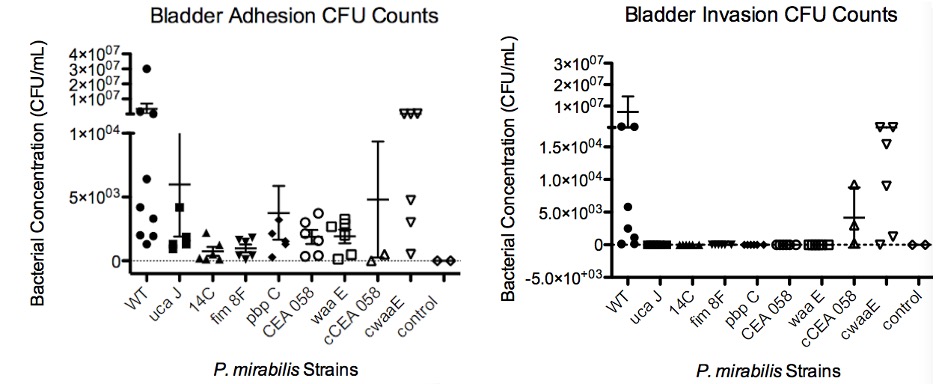Back
Poster, Podium & Video Sessions
Moderated Poster
MP05: Stone Disease: Basic Research & Pathophysiology
MP05-07: In Vitro and In Vivo Assessment of Pathogenic Properties of Proteus Mirabilis in Urinary Tract Infection and Struvite Stone Formation
Friday, May 13, 2022
8:45 AM – 10:00 AM
Location: Room 225
Roman Herout*, Sara Khoddami, Alina Reicherz, Ben Chew, Dirk Lange, Vancouver, Canada
- RH
Roman Herout, MD
University of British Columbia
Poster Presenter(s)
Introduction: Proteus mirabilis (PM) is a Gram-negative, urease-positive bacterium that is frequently detected in patients with catheterassociated urinary tract infections (CAUTIs) and the major culprit in struvite stone formation. The mechanism of PM invasion is poorly studied and the role of adhesion molecules (AM) in this process remains widely unknown.
Methods: In vitro adhesion and invasion assays were performed: kidney (HEK293, A498) and bladder cells (T24) were exposed to wild type (WT) or one of six different mutant strains (MS) of PM with deficiencies in AMs. Cells were incubated for 2 and 24h, lysed for CFU counts (bacterial adhesion) or treated with antibiotics to eliminate extracellular bacteria, and then lysed for quantification of invaded bacteria. Subsequently, we performed these assays in an established CAUTI mouse model. Briefly, We percutaneously introduced a 4mm catheter piece in the mouse bladder and introduced PM WT or MS percutaneously (5x10^5 bacteria) in the bladder the following day. On day 3 mice were sacrificed and bacteria on urine and catheter were quantified via CFU counts. In addition, adhesion and invasion of PM strains was assessed in bladder tissue.
Results: WT PM showed greater adhesion to HEK293, A498 and T24 cells when compared to the MS. None of the MS invaded any of the cell lines. Reintroduction of knocked out genes via complementation (cCEA and cwaaE) resulted in the return of the invasive phenotype. In vivo, WT showed higher urine, higher catheter CFU and higher bladder adhesion counts when compared to the MS. The inability of the MS to invade bladder cells was also demonstrated in the in vivo setting (figure 1), and reversed via complementation of functional genes.
Conclusions: We identified key outer membrane components of PM critical for its ability to invade uroepithelial cells, important in the context of recurrent UTIs and recurrent struvite stone formation. Further studies aimed at understanding the importance of PM invasion in struvite stone formation and recurrence will validate these outer membrane components as targets for future therapeutic agents in the prevention of serious recurrent CAUTI and struvite stones.
Source of Funding: Roman Herout (HE 8701/1-1) is funded by the German Research Foundation (DFG).

Methods: In vitro adhesion and invasion assays were performed: kidney (HEK293, A498) and bladder cells (T24) were exposed to wild type (WT) or one of six different mutant strains (MS) of PM with deficiencies in AMs. Cells were incubated for 2 and 24h, lysed for CFU counts (bacterial adhesion) or treated with antibiotics to eliminate extracellular bacteria, and then lysed for quantification of invaded bacteria. Subsequently, we performed these assays in an established CAUTI mouse model. Briefly, We percutaneously introduced a 4mm catheter piece in the mouse bladder and introduced PM WT or MS percutaneously (5x10^5 bacteria) in the bladder the following day. On day 3 mice were sacrificed and bacteria on urine and catheter were quantified via CFU counts. In addition, adhesion and invasion of PM strains was assessed in bladder tissue.
Results: WT PM showed greater adhesion to HEK293, A498 and T24 cells when compared to the MS. None of the MS invaded any of the cell lines. Reintroduction of knocked out genes via complementation (cCEA and cwaaE) resulted in the return of the invasive phenotype. In vivo, WT showed higher urine, higher catheter CFU and higher bladder adhesion counts when compared to the MS. The inability of the MS to invade bladder cells was also demonstrated in the in vivo setting (figure 1), and reversed via complementation of functional genes.
Conclusions: We identified key outer membrane components of PM critical for its ability to invade uroepithelial cells, important in the context of recurrent UTIs and recurrent struvite stone formation. Further studies aimed at understanding the importance of PM invasion in struvite stone formation and recurrence will validate these outer membrane components as targets for future therapeutic agents in the prevention of serious recurrent CAUTI and struvite stones.
Source of Funding: Roman Herout (HE 8701/1-1) is funded by the German Research Foundation (DFG).


.jpg)
.jpg)